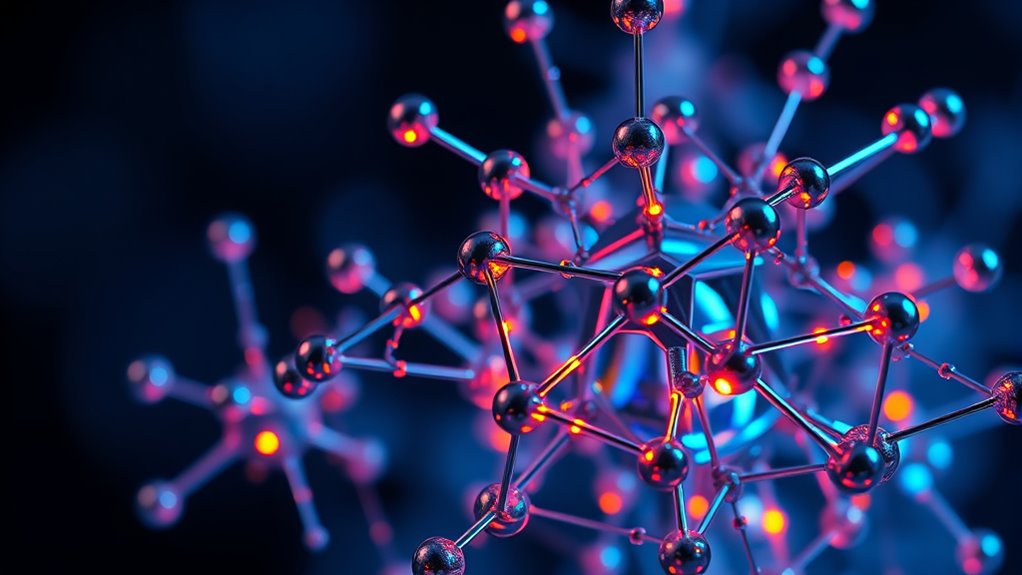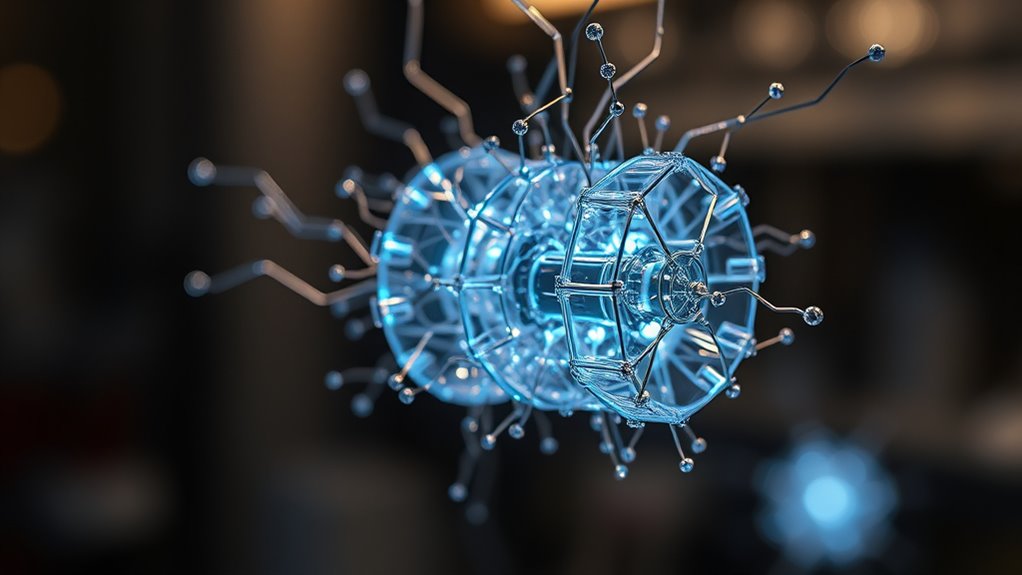You use computational approaches to simulate nanomachines by applying techniques like molecular dynamics, quantum modeling, and multiscale methods. These tools help you understand atomic interactions, electronic behaviors, and larger structural responses across different scales. Accurate force fields, quantum calculations, and hybrid models improve predictions of nanomachine performance, stability, and functionality. Continuing with this information reveals how these strategies work together to advance nanotech design and innovation, offering deeper insights into nanoscale systems.
Key Takeaways
- Atomistic simulations like Molecular Dynamics utilize force fields to model atomic interactions and predict nanomachine behavior under various conditions.
- Quantum mechanical models, including DFT and tunneling analyses, provide insights into electron behavior and electronic properties at the nanoscale.
- Multiscale modeling combines quantum, atomistic, and continuum approaches to capture phenomena across different spatial and temporal scales.
- Computational techniques optimize nanomachine design by simulating stability, flexibility, and responses to temperature and pressure variations.
- Advanced algorithms, machine learning, and high-performance computing enhance simulation accuracy, efficiency, and predictive capabilities in nanomachine research.
Fundamental Principles of Nanomachine Simulation

Understanding the fundamental principles of nanomachine simulation is essential for accurately modeling their behavior at the atomic and molecular levels. You need to grasp how atoms and molecules interact, which involves forces like van der Waals, electrostatic, and covalent bonds. These interactions determine how nanomachines move, assemble, and function. You also must consider energy minimization, ensuring the system reaches a stable configuration. Temperature effects, quantum effects, and mechanical constraints influence the simulation’s accuracy. By understanding these core principles, you can set appropriate parameters and choose suitable computational models. This foundational knowledge enables you to predict nanomachine behavior reliably, guiding experimental design and advancing nanotechnology applications. Recognizing these principles is critical for meaningful and precise simulation results. Yoga
Molecular Dynamics Techniques in Nanotechnology

Molecular dynamics techniques rely on atomistic simulation principles to model nanomachine behavior accurately. You’ll explore how force field applications determine interactions, while temperature and pressure effects influence system stability. Understanding these points helps optimize nanodevice performance at the atomic level. Additionally, selecting vetted materials ensures safety and effectiveness in nanotechnology applications.
Atomistic Simulation Principles
Atomistic simulation principles form the foundation of molecular dynamics (MD) techniques, enabling you to model the behavior of nanomachines at the atomic level. These principles rely on simulating the interactions between individual atoms and molecules over time, capturing their motion and responses to forces. You start by defining initial positions and velocities, then apply Newton’s laws to update atomic trajectories. The accuracy of your simulation depends on the time step size and the potential functions used to describe interatomic forces. By following these principles, you can observe how nanostructures respond to environmental changes, identify structural stability, and predict dynamic behaviors. This approach provides detailed insights into the fundamental processes governing nanomachine functions without averaging or macroscopic assumptions. Additionally, implementing cybersecurity measures ensures the integrity and security of simulation data against potential cyber threats.
Force Field Applications
Have you ever wondered how nanomachines accurately simulate atomic interactions? That’s where force field applications come in. Force fields are mathematical models that estimate the potential energy of a system based on atomic positions, allowing you to predict how atoms will interact. They define parameters for bonds, angles, dihedrals, and non-bonded interactions like van der Waals forces and electrostatics. By applying these force fields, you can run molecular dynamics simulations to observe how nanomachines behave under different conditions. Different force fields, such as CHARMM, AMBER, or ReaxFF, suit various materials and scenarios. Using the right force field guarantees your simulation accurately reflects real atomic interactions, providing insights into structural stability, conformational changes, and mechanical properties at the nanoscale. Additionally, incorporating AI-enabled tools can enhance the precision and efficiency of your simulations.
Temperature and Pressure Effects
Temperature and pressure considerably influence the behavior of nanomachines, and molecular dynamics simulations are essential tools for exploring these effects. By adjusting temperature, you can observe how nanomachine stability, flexibility, and conformations change, revealing thermal resilience or failure points. Elevated pressures help you understand how nanostructures respond to compression or deformation, critical for designing durable devices. MD simulations enable you to replicate real-world conditions, providing insights into phase transitions, diffusion rates, and mechanical properties at the atomic level. You can monitor how temperature fluctuations cause structural rearrangements or how pressure impacts molecular interactions. Incorporating accurate force fields into your simulations enhances predictive reliability, ensuring your models closely mimic real-world behaviors. This detailed understanding allows you to optimize nanomachines for specific environments, ensuring they perform reliably under variable thermal and pressure conditions.
Quantum Mechanical Modeling of Nanoscale Systems

Quantum mechanical modeling allows you to analyze phenomena like tunneling effects that classical models can’t explain. You can simulate electron behavior at the nanoscale to better understand how nanomachines operate. This approach provides critical insights into designing more efficient and accurate nanoscale devices. Additionally, understanding security vulnerabilities can help in developing safer and more reliable nanotechnologies.
Quantum Tunneling Effects
Understanding quantum tunneling is essential when modeling nanomachines because it allows particles to pass through energy barriers that classical physics would deem impenetrable. This phenomenon occurs because particles exhibit wave-like behavior, giving them a probability of appearing on the other side of a barrier. You need to incorporate tunneling effects into your models to accurately predict nanomachine performance, especially in electronic and molecular systems. Ignoring tunneling can lead to underestimating current flow or reaction rates at the nanoscale. Computational approaches, such as the Wentzel-Kramers-Brillouin (WKB) approximation or quantum Monte Carlo simulations, help quantify tunneling probabilities. By accounting for these effects, you improve the precision of your simulations and better understand how nanomachines function under quantum mechanical principles. Quantum effects are fundamental to understanding behaviors at the nanoscale.
Electron Behavior Simulations
Simulating electron behavior at the nanoscale requires applying quantum mechanical models that capture the particles’ wave-like nature. You’ll use methods like density functional theory (DFT) and Schrödinger equation solutions to analyze how electrons interact within nanostructures. These models help predict electronic properties, conductance, and energy levels, essential for designing nanodevices. You need to contemplate quantum confinement effects, where electrons behave differently in confined spaces, affecting device performance. By employing computational techniques such as tight-binding or ab initio calculations, you can obtain detailed insights into electron distributions and progressions. Understanding quantum effects is fundamental for accurately modeling electron behavior at the nanoscale. These simulations enable you to understand and optimize nanoscale systems, ensuring your nanomachines function efficiently at the quantum level. Accurate electron behavior modeling is crucial for advancing nanotechnology applications.
Multiscale Approaches for Complex Nanomachines

To effectively design and analyze complex nanomachines, researchers often rely on multiscale approaches that bridge different levels of detail. These methods combine techniques like quantum mechanics, molecular dynamics, and continuum models to capture phenomena across scales. By doing so, you can simulate atomic interactions while also accounting for larger structural behaviors, making models more accurate and computationally feasible. Multiscale approaches enable you to study how molecular-level changes impact overall function, which is vital for designing efficient nanomachines. They help you balance detail and practicality, reducing computational costs without sacrificing essential insights. This integration allows for better predictions of mechanical, chemical, and biological performance, ultimately guiding you toward more effective nanomachine development and optimization. Additionally, leveraging knowledge of efficient payment solutions can inform the development of integrated control systems for nanomachines, enhancing their reliability and performance.
Challenges and Limitations of Computational Modeling

While multiscale approaches have advanced the modeling of nanomachines, they also introduce significant challenges. Managing the complexity across different scales demands substantial computational resources and sophisticated algorithms. Accurately linking quantum, atomic, and continuum models often results in approximations that can reduce precision. You may encounter limitations in simulation timeframes, making it difficult to capture long-term behaviors or rare events. Additionally, the scarcity of reliable experimental data hampers validation efforts, leading to uncertainties in model predictions. Simplifications necessary for computational feasibility can overlook critical interactions, affecting the accuracy of results. Vetted – Grobal World These challenges require careful balancing between detail and efficiency, pushing you to continually refine models and develop new methods to overcome inherent limitations in simulating nanomachines effectively.
Future Directions in Nanomachine Simulation

Advancements in computational power and algorithm development are opening new avenues for the future of nanomachine simulation. You’ll soon see more accurate models that capture complex behaviors at the molecular level. Machine learning and AI will enhance predictive capabilities, enabling faster design iterations. Hybrid approaches combining classical and quantum methods will provide deeper insights into nanoscale interactions. Cloud computing and high-performance clusters will make large-scale simulations accessible to more researchers. To illustrate, consider this table:
| Future Focus | Expected Impact |
|---|---|
| AI-driven modeling | Accelerated discovery and optimization |
| Quantum simulations | Better understanding of quantum effects |
| Multiscale approaches | Integrated insights across scales |
| Cloud computing access | Broader collaboration and data sharing |
| Automated design tools | Streamlined nanomachine development |
These directions will redefine how you develop and understand nanomachines.
Frequently Asked Questions
How Do Environmental Factors Influence Nanomachine Behavior Prediction?
Environmental factors substantially impact your ability to predict nanomachine behavior. Temperature fluctuations can alter reaction rates, while changes in pH or ionic strength affect interactions and stability. You must incorporate these variables into your models to improve accuracy. External forces like electromagnetic fields or fluid flow can also influence nanomachine performance. By accounting for these environmental influences, you guarantee your simulations are more reliable and reflective of real-world conditions.
What Are the Ethical Considerations in Nanomachine Simulation Research?
You should consider ethical issues like safety, privacy, and potential misuse when conducting nanomachine simulation research. It’s essential to evaluate the risks of unintended consequences, including environmental impact and health concerns. Responsible practices involve transparency, adherence to regulations, and engaging with the broader community. By doing so, you guarantee your work benefits society without causing harm, fostering trust and promoting ethical innovation in nanotechnology.
Can Current Models Accurately Predict Experimental Nanomachine Performance?
No, current models can’t perfectly predict nanomachine performance, despite all the hype. You might think simulations are crystal balls, but they often miss complex behaviors at the nanoscale. While they provide valuable insights, they still struggle with accuracy and real-world variability. So, you’re left relying on experimental validation and continuous refinement, knowing that your models are more of a helpful guide than a definitive answer.
How Do Computational Costs Impact Large-Scale Nanomachine Simulations?
Computational costs considerably impact large-scale nanomachine simulations by limiting their complexity and scale. You might face longer processing times and higher resource demands, which can hinder detailed modeling. To manage this, you’d need to optimize algorithms, use approximations, or leverage high-performance computing. While these strategies help, they still require balancing accuracy against computational feasibility, often constraining the scope of simulations you can realistically perform.
What Role Does Machine Learning Play in Advancing Nanomachine Modeling?
Machine learning accelerates nanomachine modeling by enabling you to predict complex behaviors more efficiently. It helps you analyze vast datasets, identify patterns, and optimize designs faster than traditional methods. You can develop accurate models with less computational effort, allowing for real-time simulations and iterative improvements. By integrating machine learning, you enhance the precision and scalability of your nanomachine simulations, ultimately pushing the boundaries of what’s possible in nanotechnology research.
Conclusion
As you navigate the world of nanomachines, remember that each computational approach acts like a brushstroke on a vast canvas, revealing tiny worlds unseen. Though challenges loom like shadows, your innovations and breakthroughs will light the path forward. Embrace the dance of molecules and quantum whispers, for in this intricate choreography lies the future. Keep pushing boundaries, and you’ll open the symphony of possibilities within the nanoscopic universe.









